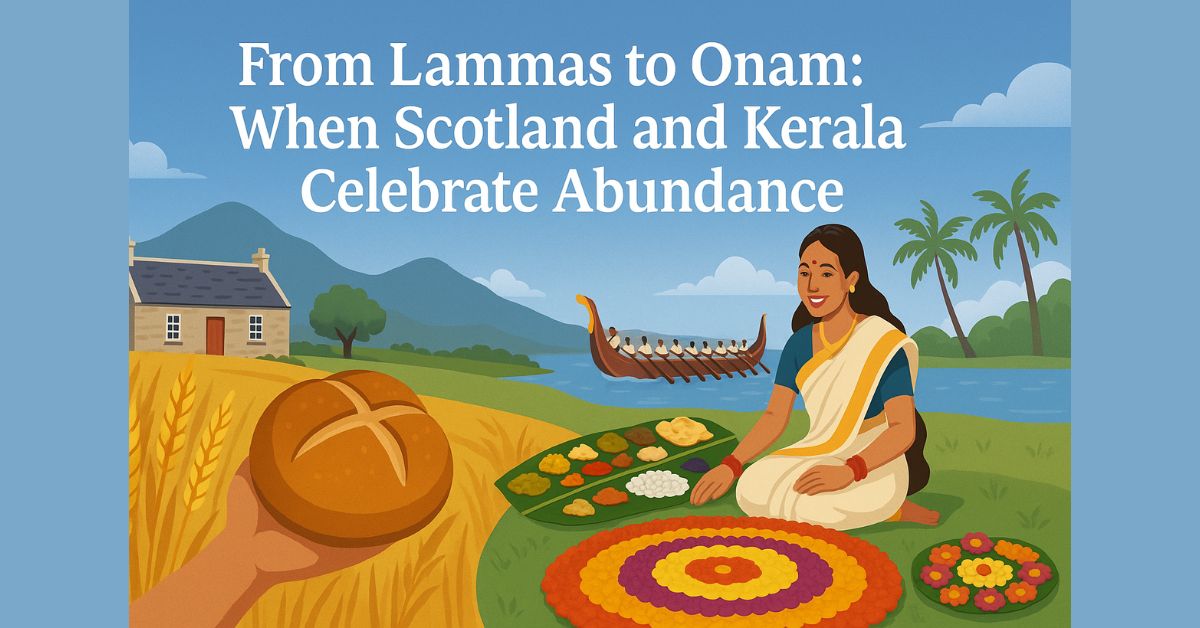Onam and Lammas harvest festivals may be worlds apart in geography, but they share striking similarities in spirit. From Kerala’s grand Onam celebrations to Scotland’s ancient Lammas traditions, both mark the abundance of harvest, the joy of community, and the gratitude that binds people together. This page explores how these two traditions echo one another and what they mean for the Scottish-Indian diaspora.
Festivals of harvest are as old as humanity itself. Wherever crops grow and communities gather, celebrations of abundance, gratitude, and togetherness naturally emerge. They remind us that across cultures and continents, people share the same instinct: to pause, give thanks for the bounty of the earth, and share that blessing with others.
In Kerala, the southern state of India, this gratitude takes shape in the festival of Onam, one of the most vibrant and unifying celebrations in the Indian calendar. In Scotland, similar echoes can be heard in Lammas and Lughnasadh, ancient harvest traditions rooted in Celtic and Christian practices.
Though oceans apart, Onam and Scotland’s harvest festivals carry striking similarities. Both are about food, community, symbolism, and the joy of marking plenty after periods of uncertainty. For the Scottish-Indian diaspora, reflecting on these connections offers a chance to appreciate how two very different homelands share common rhythms of life.
🌼 Onam: Kerala’s Festival of Abundance
Onam is much more than a harvest festival,it is Kerala’s grandest celebration, rooted in history, mythology, and cultural pride. Lasting ten days, it marks the legendary return of King Mahabali, a ruler remembered for his just and generous reign. According to lore, Mahabali visits his people once a year, and Onam is the joyous welcome offered in his honour.
The festival is woven with symbolic traditions:
- Pookalam: intricate floral carpets laid out in courtyards.
- Onam Sadya: a grand vegetarian banquet, served on banana leaves, often with more than 20 dishes ranging from avial to payasam.
- Vallam Kali: the iconic snake boat races across Kerala’s backwaters.
- Pulikali & Kathakali: colourful folk dances and dramatic performances.
At its heart, Onam is a community festival. Families gather, neighbours cook together, and the state comes alive with unity across caste, creed, and religion. In the diaspora, Malayali communities recreate this spirit wherever they are—be it a church hall in Glasgow or a community centre in Edinburgh, where Onam sadya is shared with Scottish friends who marvel at the flavours and colours.
🌾 Lammas and Lughnasadh: Scotland’s Harvest Heritage
Scotland too has its traditions of celebrating the harvest. In fact, Lammas, observed on 1st August, is one of the oldest known festivals in the British Isles. The word itself comes from “Loaf Mass”, when the first loaves baked from the new wheat crop were taken to church as an offering of thanks. Communities marked it with fairs, feasts, and blessings of food.
Even earlier, in Celtic times, Lughnasadh (pronounced Loo-na-sah) was celebrated in honour of the god Lugh, a deity associated with skills, harvest, and community. It was a festival of “first fruits,” where people came together for feasts, games, and gatherings. Handfasting ceremonies (trial marriages for a year and a day), athletic contests, and communal meals were all part of the tradition.
Though largely faded from mainstream life, these celebrations survive in fragments: Lammas fairs in small Scottish towns, revived pagan gatherings marking Lughnasadh, and even church harvest services in late summer. At their core, they were about acknowledging nature’s gifts and reinforcing bonds of community.
Explore more festivals and cultural traditions at our Community and Culture section.
📅 Celebration Timings & Seasonal Parallels
Another fascinating link between Kerala and Scotland lies in when these festivals take place.
- Onam in Kerala
- Celebrated in Chingam, the first month of the Malayalam calendar (August–September).
- The festival lasts 10 days, culminating in Thiruvonam day.
- It marks the rice harvest that follows Kerala’s life-giving monsoon rains.
- Lammas in Scotland
- Observed on 1st August, halfway between the summer solstice and autumn equinox.
- Known as the time of the first grain harvest, especially wheat and barley.
- Traditionally, loaves baked from this fresh grain were offered in church as a blessing.
- Lughnasadh (Celtic tradition)
- Began at sunset on 31st July and continued into 1st August.
- Marked the “first fruits” harvest, celebrated with feasts, games, and fairs.
What stands out is that despite being separated by geography and climate, both cultures chose the threshold of abundance. The very first signs of a successful harvest and as the moment to pause, celebrate, and give thanks.
In Kerala, it is rice that signals security; in Scotland, it is wheat and barley. Different grains, same human instinct. For the diaspora, these timings offer a symbolic bridge: August into September becomes a global season of gratitude, whether marked by sadyas or loaves of Lammas bread.
🌍 Shared Threads Across Continents
When we place Onam and Scotland’s harvest festivals side by side, fascinating similarities emerge:
1. The Centrality of Food
Just as the Onam Sadya gathers families around banana leaves piled with curries, pickles, and sweets, Lammas centred around bread baked from the first wheat. In both cases, sharing food is more than nourishment, it is ritual. It symbolises gratitude and generosity.
2. Community and Inclusivity
Onam is famously celebrated across religions in Kerala. Similarly, Lammas and Lughnasadh were communal events, drawing together villages regardless of social divisions. Festivals level the field: whether you are rich or poor, everyone shares the harvest’s bounty.
3. Celebration Through Art and Performance
From Kerala’s Kathakali and Pulikali dances to the games and storytelling of Lughnasadh, both festivals emphasise performance, play, and spectacle. They are not solemn occasions but joyous, theatrical expressions of life’s abundance.
4. Seasonal Symbolism
Onam marks the rice harvest in Kerala, while Lammas and Lughnasadh honour the ripening of wheat and barley. Different crops, different climates but the same impulse to acknowledge the turning of the seasons and the sustenance it provides.
5. Spiritual Reflection
Both festivals carry deeper meanings beyond the feasts and fun. Onam’s legend of King Mahabali speaks to themes of humility, justice, and the cyclical nature of life. Lammas and Lughnasadh, too, carry spiritual undertones—of sacrifice, renewal, and thankfulness to divine or natural forces.
✨ A Diaspora Perspective: Blending Traditions
For the Scottish-Indian diaspora, these parallels are more than just interesting footnotes in cultural history. They are living opportunities for fusion. Imagine:
- Hosting an Onam Sadya in Scotland, but starting with a symbolic loaf of Lammas bread placed at the centre of the table.
- Creating a fusion pookalam not just with marigolds and chrysanthemums, but with Scottish heather and thistles.
- Combining Onam’s storytelling of King Mahabali with Celtic myths of Lugh, exploring how legends shape our values.
Diaspora life often means carrying multiple cultural identities. Rather than choosing one over the other, blending traditions allows us to celebrate abundance in a way that feels uniquely our own. An Onam in Scotland might feature payasam alongside shortbread—or even a thoran with neeps and tatties!
Drawing links between Onam and Scotland’s harvest traditions is not just an academic exercise. It is a reminder that cultures are not isolated silos. Human societies—whether in tropical Kerala or rugged Highland glens—respond to the same cycles of nature in remarkably similar ways.
By spotlighting these connections, ScottishIndian.com affirms something powerful: diaspora is not about being divided between “here” and “there,” but about weaving both into a richer tapestry of belonging. When we gather in Edinburgh or Aberdeen to mark Onam, we stand in continuity not just with Kerala’s fields of rice but also with Scotland’s golden wheat and barley.
As the pookalams bloom and sadyas are served this Onam, let us also remember the Lammas loaves and Lughnasadh feasts that once marked Scotland’s late summer. Both traditions teach us the same timeless lesson: life is abundant when shared.
In Scotland and in Kerala, across time and distance, harvest festivals remain a call to gratitude, community, and joy. For the diaspora, they remind us that while roots may stretch across continents, the spirit of celebration is universal.
✍️ At ScottishIndian.com, we celebrate these bridges between Scotland and India, past and present, tradition and adaptation. May your Onam this year be filled with abundance, and may you find echoes of that joy in Scotland’s own harvest heritage.






